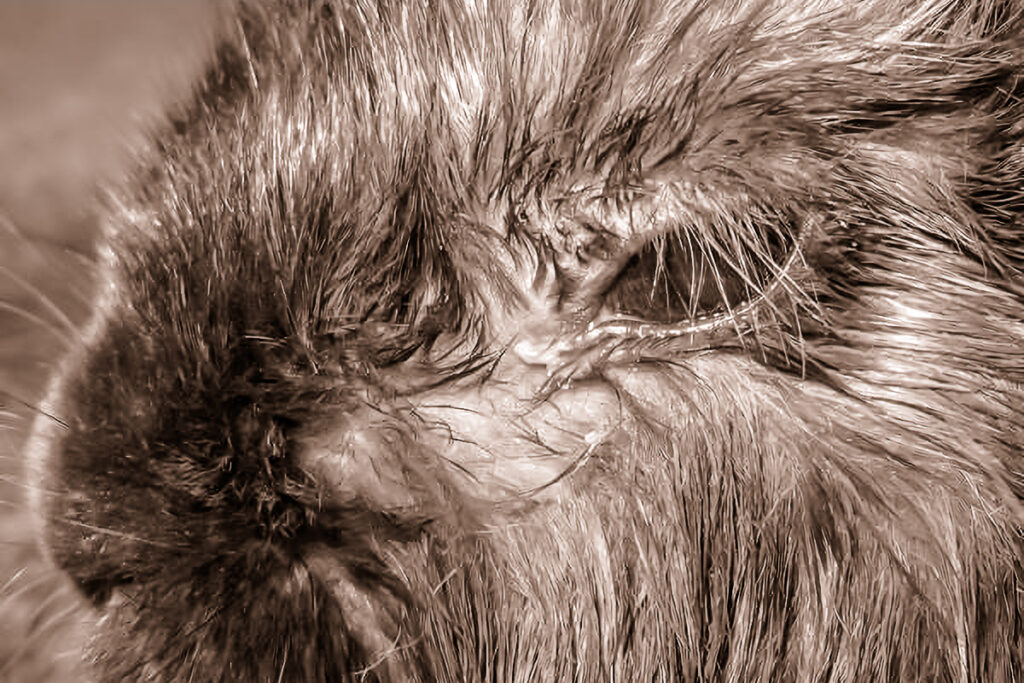We hear the complaint often: “My rabbit constantly has runny eyes. The vet gave us antibiotics, and it cleared up for a while. But once we stopped, it came right back.”
Normally, protective tears continuously bathe the eye, and are drained away via the nasolacrimal canal (“tear duct”), a tiny, mucous-membrane-lined tube. The opening of the canal, the punctum, is located in the corner of the eye closest to the nose (medial canthus). The duct goes through the skull and empties tears into the nasal cavity.
Abnormal overflow of tears is known as epiphora. While not life-threatening, it can be troublesome and frustrating: constantly wet fur and skin promotes bacterial growth, resulting in inflammation, fur loss, and discomfort. Causes of the problem are varied, so a correct diagnosis is essential for effective treatment. Your vet may refer you to a veterinary ophthalmologist if the condition requires the expertise of an eye specialist.
Conditions That Cause Obstruction Of Normal Tear Drainage
In rabbits, one of the most common reasons for epiphora is obstruction of one or both nasolacrimal canals. There are several ways this can occur.
Congenital Problems
Some rabbits, particularly those with short faces (e.g., lop and dwarf), are born with abnormally narrow or even kinked tear ducts, and can be prone to chronic tearing. If their abnormal anatomy is subjected to additional challenges (see below), then chronic epiphora can result.
Acquired Problems I:
External Pressure on the Duct
Many rabbits with no history of runny eyes in their youth can later exhibit this condition for a variety of reasons.
The Dental Connection: Rabbits have open-rooted molars and incisors that grow throughout the bunny’s life. The bases of some molars are located just under the eye and tear duct. Abnormalities around these molar roots can press on the tear duct and cause narrowing or complete obstruction.
Dental Infection: Pressure from abscess/inflammation of the upper molar roots can cause partial or complete obstruction. While removal of a bad tooth may be important in treating infection, it may not resolve the associated runny eyes. Scarring can block a tear duct as effectively as the original abscess. If this is the case, then the runny eye will likely be a lifelong affliction.
Maxillary Osteoporosis: The rabbit skeleton are light to begin with. As bone density decreases with age, dental problems affecting the tear duct can develop. In a thinning mandible (jaw) or maxilla (skull bone housing the upper dental arcade), normal chewing pressure can gradually drive molar roots deeper into the bone. In the maxilla, intruding roots can pinch off the tear ducts.
Abnormal masses: Neoplasias (cancers) in the sinus, eye, or bone around the tear duct can exert enough pressure to narrow the tear ducts. Injuries to the face or eye, and even trauma from medical procedures, such as facial surgery or tear duct cannulation, can sometimes block the ducts.
Inflammation from other conditions: Swelling of mucous membranes in the sinuses can sometimes extend to the tear duct lining. Hence, conditions such as upper respiratory infection, conjunctivitis, or infection in the tear duct itself can trigger a case of weepy eyes.
Acquired Problems II:
Internal Duct Disease: Sometimes the problem is inside the canal itself.
Inflammation or Infection of the lacrimal sac: Normal rabbit tears are translucent, and slightly milky in appearance. If discharge from the eye is purulent, opaque white, or has the texture of stringy mucus, then the source might be an infection in the upper end of the nasolacrimal canal, known as the lacrimal sac. The medical term for this infection is dacryocystitis. Swelling of the mucous membranes lining the ducts (or elsewhere around the eye) can be caused by bacterial or fungal infection, or by allergic reaction.
Cellular debris: Like any epithelium, the cellular lining of the nasolacrimal ducts is constantly being sloughed and replaced. Cellular debris can sometimes build up and obstruct the canal, necessitating a flush by your veterinarian.
Neurological disorders: Facial nerve paralysis resulting from surgery, trauma, or central nervous system event (e.g., stroke) can cause the eyelids to droop and allow tears to overflow. Nerve damage also can interfere with normal function of the lacrimal pump that forces tears through the nasolacrimal canal.
Conditions That Cause Overproduction Of Tears
Injury or disease of the eye can result in tear production that exceeds the drainage capacity of the nasolacrimal canals. Treatment of the primary condition will usually resolve the excess tearsCorneal injury/ulceration
The cornea is the transparent “window” covering the eye’s pupil and iris. Even an injury invisible to your naked eye can cause copious tears. Squinting and unusual sensitivity to light in the affected eye mean it’s time for a trip to the vet.
Eyelid Abnormalities
Even slight eyelid malformations, whether congenital or acquired, can interfere with normal, protective eyelid function. Eyelashes growing at an abnormal angle (trichiasis) can scratch and irritate. Entropion (eyelids rolled inwards) causes eyelashes and rough external skin to rub against the cornea. Ectropion (eyelids rolled outwards) not only irritates the cornea, but the sagging lower lids allow tears to flow out of the eye instead of into the punctum.
Meibomian glands, located inside the rim of the upper and lower eyelid, secrete an oily lubricant that increases tear viscosity. Inflamed glands have impaired function, and epiphora can result.
Some of these conditions can be treated with appropriate medications, but congenital or unresponsive problems may need surgical repair.
Conjunctivitis
Inflammation of mucous membranes cupping the eyeball (the conjunctiva) and/or the nictitating membrane (“third eyelid”) also can cause runny eyes. Conjunctivitis can cause the eye to produce thicker, stickier discharge than normal, watery tears. Pathogens or allergies are possible culprits.
Glaucoma
Abnormally high fluid pressure inside the eye is known as glaucoma. Glaucoma damages the retina and optic nerve, resulting in blindness. While not common in rabbits, it does occur. Unfortunately, glaucoma is usually asymptomatic in its earliest stages, and by the time signs of trouble appear, damage is already done. Advanced glaucoma can cause the eyeball itself to enlarge, stretching the connective tissue that provides its infrastructure, and causing inflammation of surrounding tissues. In some cases, the eye responds to this irritation with excess tears.
Diagnosis and Treatment
Your veterinarian will have many tools at his/her disposal to determine the nature of the problem causing your rabbit’s epiphora. Simple procedures such as testing your bunny’s sensitivity to light may give the vet a hint that a corneal injury is the problem. Staining the eye with a temporary dye and viewing with ultraviolet light can reveal corneal ulcers or fungal infection. Culture and sensitivity testing might be necessary if bacterial infection is suspected.
Various types of imaging (radiography, ultrasound, endoscopy) might be employed to determine whether abnormal masses are present, followed by biopsy to positively identify such lesions. Because of the wide variety of possible sources of epiphora, more than one technique might be necessary before the cause of your bunny’s ailment is identified.
If your veterinarian suspects a simple case of cellular debris blockage, the treatment might be as mild as ophthalmic drops containing antibiotics to kill bacteria and corticosteroids to reduce inflammation of the mucous membranes. If drops alone don’t solve the problem, your vet may suggest a tear duct flush (or a series of flushes). If the problem is a dental or sinus infection, your vet may prescribe topical and/or systemic medications. These may include anti-inflammatory medications, antibiantibiotics, and/or antifungal medications, depending on the pathogen(s) or processes involved.
Unfortunately, in many cases the problem recurs, and a permanent solution just isn’t possible. Lifelong palliative care may be necessary. Your vet might instruct you to use a moist, warm cloth with mild antiseptic to wipe tears and debris from the fur, so they will not accumulate and provide a bacteria-friendly environment. Severe epiphora may necessitate daily face washing with warm, running water (not something your bunny will necessarily enjoy, at least at first!).
Constant maintenance is necessary, provided either by the human caregiver or by a bonded bunny mate who is willing to groom and clean the affected areas. An especially attentive mate might groom to the point where there’s a bit of bald skin around the eye(s), but at least the weepy bunny will be more comfortable. Who knows? This might be just the reason to finally make that big decision and let your runny-eyed bunny choose that kissy bunny mate he’s been dreaming about for so long. Sometimes a good dose of love can make all the other medicines work that much better.
©Copyright Dana Krempels. All Rights Reserved. Republished with the permission of the author.
Chronic Runny Eyes In Rabbits was originally published in House Rabbit Journal Volume 5, No. 8

